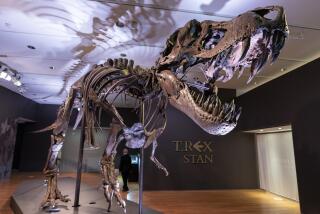Oldest of Dinosaurs Found in Argentina : The 25-pound, 3-foot-tall ancestor of Tyrannosaurus rex was a bipedal carnivore. The bones were discovered by Chicago scientists.
- Share via
Chicago scientists have discovered the oldest known dinosaur, a three-foot-tall, 25-pound ancient ancestor of Tyrannosaurus rex that walked on two legs and lived on the flesh of other species.
Discovered in the arid foothills of the Andes in Argentina, the new species, called Eoraptor, or “dawn stealer,” lived 225 million years ago. It lacked nearly all of the specialized characteristics of later, more evolved dinosaurs, but clearly was one of the first of the breed.
“We are just a couple of steps away from the ancestor of all dinosaurs,” said paleontologist Paul Sereno of the University of Chicago, who announced the discovery at a Washington press conference Tuesday. “This fossil confirms our suspicions that dinosaurs began as small, carnivorous, bipedal animals.”
Because Eoraptor was not large enough to hunt the plant-eating reptiles of the period, Sereno said, “It would have been a crafty hunter, probably eating small animals and snatching the young of larger species.”
“This is definitely an important animal,” said paleontologist Michael Brett-Surman of the Smithsonian Institution’s National Museum of Natural History. “It forces us to redefine the meat-eating dinosaur group.”
Researchers believe the first dinosaur probably emerged about 5 million to 10 million years before Eoraptor, probably following a major extinction that wiped out many land-dwelling animals and opened new environmental niches the dinosaurs could fill. They dominated the Earth until about 65 million years ago, when they disappeared, most likely as the result of a cometary impact that filled the atmosphere with light-blocking smoke and dust.
Their disappearance allowed the emergence of mammals, which eventually evolved into humans.
The discovery of such a complex dinosaur from that period suggests that dinosaur evolution proceeded rapidly. Sereno noted, however, that it lacks the hinge-like jawbone that allowed later carnivorous dinosaurs to trap and hold struggling prey. It also did not have the massive pelvic bone typical of later dinosaurs.
The absence of these features suggests that Eoraptor was present before the three main branches of the dinosaur family tree were widely separated.
But it did have the grasping, three-fingered hands characteristic of the theropod family of dinosaurs, which includes T. rex. Such hands were designed to rake flesh from the dinosaur’s prey.
The skull of Eoraptor was found in October, 1991, by Argentinian student Ricardo Martinez, who was participating in a expedition to the Ischigualasto Valley led by Sereno and paleontologist Alfredo Monetta of the National University of San Juan. Martinez was drawn by the glint of teeth in the skull, which was lying in a pile of rubble.
The team subsequently recovered all of the skeleton except for a few bones at the end of the tail. They could not be completely sure of its identity until all of the bones were carefully separated from rock and thoroughly studied, a process that took nearly a year. A full description of Eoraptor will be published in the British journal Nature on Thursday.
Scientists have now identified 350 separate species of dinosaurs, half of them in the last 20 years.
More to Read
Sign up for Essential California
The most important California stories and recommendations in your inbox every morning.
You may occasionally receive promotional content from the Los Angeles Times.









